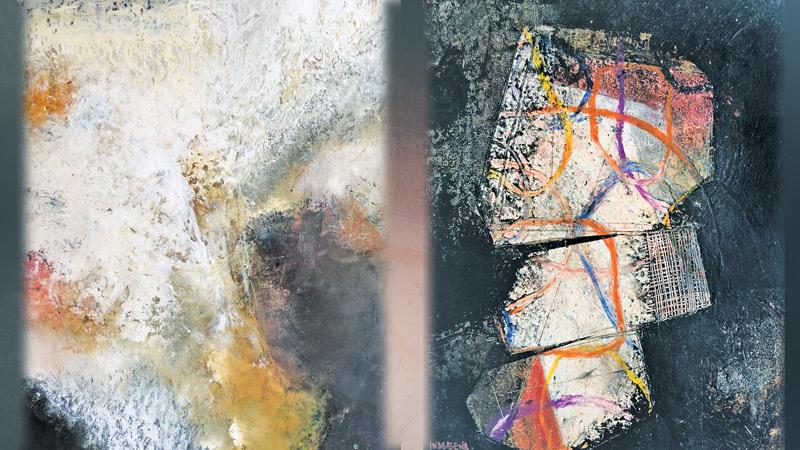
Those who doubt that contemporary abstraction can emotionally move viewers should step into Barefoot Gallery this evening to witness Nalin Indrasena’s Luminous Emptiness. Luminous Emptiness demonstrates just how moving contemporary abstract could be. The series of abstract painting collection curated in a way that allows the eye to sweep from one painting to another with abstract certainty in Luminous Emptiness can surely be identified as one of the strongest collections presented by the Barefoot Gallery in the recent past.
Luminous Emptiness consists of eight series of abstract painting collections named, Walls of Nineveh, Dedications to Our Planet, The Canyon, Memories of Trees, River Nile, Nimrud, Autumn in Black Forest and Rheine Falls. The mysterious ability of every one of them to embody a natural phenomena was apparently a chance direction and at the same time to present a ‘picture’ of that embodiment was absolutely mind-blowing.
Luminous Emptiness is a serious, enthralling series of collection, balancing intricate lines swirling in motion laced upon a deep pool of colour, that beckons viewers to explore the nostalgic stories of historical places that Indrasena had visited. The eight titles place the work in the realm of historical places and seemingly references to its present forms that may have been originally familiar to visitors before embarking on the more unusual path. Appearing much like an architectural design Luminous Emptiness is a cold wax painting collection. The thick lines within the work appear as fine geometrical lines, connecting Indrasena’s professional practices as an engineer.
As the artist himself notes in the catalogue, Luminous Emptiness is a series of gestural work that portrays the juxtaposition of vivid cultures and physical devastation in unique places that I have visited. Unfortunately, some of these places no longer exist due to deliberate destruction or natural deterioration, leaving what remains, to be preserved in memories or told through nostalgic stories. In my paintings the emptiness in the form relates to the presence (or absence) of these historical places, while the luminosity describes the richness of cultures, art and its people’.
Moving from one painting to another, Luminous Emptiness seemed unwilling to settle upon any particular series for its viewers. Because each series had his authentic signature and also the work was curated to fully compliment the surrounding artwork. As a viewer, I see the curation as peaceful yet anticipatory sensations began to settle in as I started to examine the art more closely. The peace and bliss which transcends each and every painting has been a recurring reaction to the exhibition. As the power of the art begins to seep in, any viewer would feel a comforting calm as well as subtle energy. Undoubtedly, the serene atmosphere of Barefoot Gallery has only magnified this feeling.
Walls of Nineveh, the intricate painting series make wonderful use of the white space which accentuates the delicate journey stretching across the wall in vibrant luminous patches. Rendered in cold wax, oil mixed media, the work is executed in minute detail using mostly a pallet knife as if the depth Indrasena looks for in his paintings cannot be achieved with a paint brush.
“Through the use of oil and cold wax mixed media together with various forms of pigments, I am able to selectively reduce the surface of the painting to bring out the multitude of hidden layers creating depth and a sense of fragility,” Indrasena said. Singularities and repetitions are reflected in some of his paintings which are based on specific places, moments or conditions. The vast horizons of Iraq to the magnanimity of Beqaa Valley in Lebanon, to the parched landscapes of Jordan, and the breathtaking mountains of Switzerland are just a few examples.
“Talking about the history of my collection, Luminous Emptiness is a two year project I have been involved in and all these paintings are about the places I visited. I visited the ruins of Croatia, Ruwanda, Lebanon, Iraq and Jordan. Most of what I saw there I brought under the theme of Luminous Emptiness, and depicted those places and things not as they were, but in an abstract form,” Indrasena explained.
To read or understand an abstract painting is a somewhat critical process. In every painting of Luminous Emptiness collection, it feels like the artist is playing a secret game with the viewer. Although Indrasena says the collection is about the places he visited, buildings, architecture, people and trees are missing in his painting. But we see balancing elaborated lines laced upon a deep pool of colour and it is like a photograph; but taken out of all the geometrical lines, people and every living thing, yet the colours, mood and feel would remain. Indrasena as an artist proves that for some artistes, it seems that colour is the primary means, sparking a dialogue between artifice and nature.
“The medium I paint is cold wax. It becomes mixed media when you mix it with cold wax and oil paint. It’s called oil pigments, and is like crayons but not crayons. These drawings are used in conjunction with them. I haven’t used a paint brush here but I used small paint rollers, pallet knives and tiny equipment used to repair watches. As I live in Switzerland it’s easy to access these equipment,” Indrasena said.
Luminous Emptiness brings strange familiarity to viewers as you begin to be familiar about the places by looking at them for a few minutes and it begins to reveal the mystery it carried for thousands of years and is only a matter of time when you begin to get angry, realizing how much of civilization has been taken away from us.
